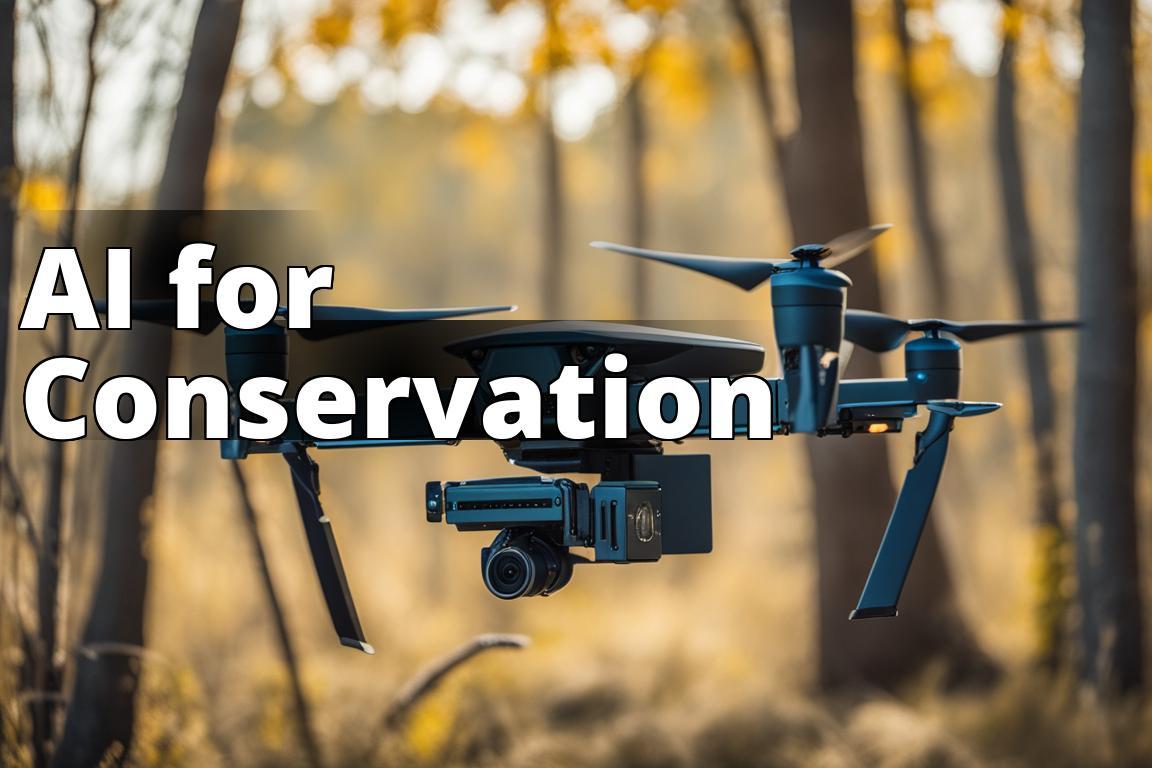Can AI software aid in wildlife conservation efforts? In recent years, the intersection of artificial intelligence (AI) and wildlife conservation has sparked significant interest and discussion. AI, with its potential to revolutionize various industries, is now being harnessed to aid in wildlife conservation efforts. This article aims to explore the role of AI software in wildlife conservation, addressing its potential applications, benefits, challenges, and ethical considerations.
Contents hideLearn how AI software can aid wildlife conservation efforts
- AI software can be used for monitoring and analyzing wildlife populations in real-time.
- It can process large datasets to identify patterns and trends in wildlife behavior using machine learning algorithms.
- AI has the potential to detect and prevent poaching activities and help in ecosystem modeling and conservation planning.

Monitoring and Surveillance Using AI
AI software plays a crucial role in monitoring and analyzing wildlife populations. By leveraging advanced algorithms, AI can process vast amounts of data derived from satellite imagery, camera traps, and acoustic sensors to track the movement and behavior of endangered species. This real-time monitoring capability allows conservationists to gain valuable insights into animal populations and their habitats, enabling more informed decision-making.
The integration of AI with drones, cameras, and sensors has significantly enhanced data collection in remote and inaccessible areas. These technologies, when combined with AI algorithms, enable the efficient collection and analysis of visual and spatial data, providing conservationists with a comprehensive understanding of wildlife habitats and ecosystems.
The real-time monitoring capabilities offered by AI software have immense benefits for wildlife conservation. Conservation organizations can detect and respond to threats such as poaching or habitat destruction promptly. This proactive approach allows for the implementation of targeted conservation interventions, ultimately contributing to the preservation of vulnerable species and their habitats.

Data Analysis and Pattern Recognition
AI’s capacity to process large datasets swiftly and accurately is instrumental in identifying patterns and trends in wildlife behavior. By analyzing data on animal movements, habitat usage, and environmental variables, AI software can provide valuable insights into ecological dynamics, contributing to more effective conservation strategies.
Machine learning algorithms, a subset of AI, are being employed for species identification and habitat mapping. Through the analysis of imagery and sensor data, AI-powered systems can distinguish between different species and map their habitats with a high degree of precision. This capability is invaluable for conservationists seeking to monitor and protect biodiversity hotspots.
AI software can aid in predicting and mitigating human-wildlife conflicts by analyzing historical data on human and animal activities. This predictive capacity allows conservationists and local communities to proactively implement measures to minimize conflicts, thereby fostering coexistence between humans and wildlife.
For instance, in a study conducted by the Centre for Wildlife Studies, AI-powered data analysis was used to identify movement patterns of endangered species, leading to targeted conservation efforts.
| AI Application | Description |
|---|---|
| Detection of poaching activities | AI software analyzes sensor data and surveillance imagery to identify suspicious activities in protected areas, aiding in the prevention of poaching. |
| Identification of trafficking routes | AI aids in the identification of trafficking routes and networks associated with illegal wildlife trade through the analysis of transportation records and market trends. |
| Law enforcement support | AI-powered predictive models and data analytics enable law enforcement agencies to strategically allocate resources and conduct targeted operations against wildlife trafficking. |

AI in Anti-Poaching and Combating Illegal Wildlife Trade
AI exhibits immense potential in detecting and preventing poaching activities through the analysis of sensor data and surveillance imagery. By employing pattern recognition algorithms, AI software can identify suspicious activities in protected areas, enabling authorities to intervene and apprehend poachers.
AI software aids in identifying trafficking routes and networks associated with illegal wildlife trade. Through the analysis of complex data sets, including transportation records and market trends, AI can uncover hidden connections and hotspots of illegal wildlife trafficking, empowering law enforcement agencies to disrupt criminal networks effectively.
The integration of AI software into law enforcement efforts has significantly bolstered the fight against wildlife crime. AI-powered predictive models and data analytics enable law enforcement agencies to allocate resources strategically and conduct targeted operations, leading to increased seizures and arrests related to wildlife trafficking.

Ecosystem Modeling and Conservation Planning with AI
AI software is instrumental in ecosystem modeling, allowing conservationists to simulate the impact of various conservation interventions on ecosystems. By running predictive models, AI can forecast the outcomes of different conservation strategies, aiding in the selection of the most effective approaches for preserving biodiversity.
The optimization of conservation strategies and resource allocation is facilitated by AI’s ability to process complex ecological data. Through the identification of ecological patterns and interactions, AI empowers conservation practitioners to allocate resources more efficiently, maximizing the effectiveness of conservation initiatives.
AI’s analytical capabilities are pivotal in addressing complex ecological challenges, such as habitat degradation and climate change. By analyzing multidimensional ecological data, AI software can provide valuable insights to guide conservation efforts aimed at mitigating environmental threats and safeguarding biodiversity.
Case Studies and Success Stories
Numerous real-world examples illustrate the impactful role of AI software in wildlife conservation. Projects leveraging AI for wildlife monitoring, anti-poaching efforts, and conservation planning have demonstrated promising results, showcasing the tangible benefits of integrating AI into conservation practices.
The successful outcomes of AI-driven conservation initiatives underscore the transformative impact of AI on wildlife conservation. From the protection of endangered species to the mitigation of human-wildlife conflicts, AI has proven to be a valuable tool in advancing conservation goals and achieving positive outcomes for biodiversity conservation.
The potential for scaling up AI-based solutions in wildlife conservation is vast. As AI technologies continue to evolve, there is an opportunity to integrate AI at a broader scale, enabling conservation organizations to leverage advanced analytics and automation to address conservation challenges more comprehensively.
Real-Life Impact of AI in Wildlife Conservation
Saving the Elephants: A Story of AI in Action
In the Maasai Mara region of Kenya, conservationist Sarah has been leading efforts to protect the local elephant population from poaching. With the help of AI-powered drones and surveillance cameras, Sarah and her team have been able to monitor the elephants’ movements in real-time, identifying potential threats and responding swiftly to protect the endangered animals.
The AI software analyzes the data collected by the drones and cameras, allowing Sarah to recognize patterns in poaching activities and identify high-risk areas. This has enabled her team to intervene effectively, leading to a significant reduction in elephant poaching incidents in the region.
Sarah’s experience demonstrates the tangible impact of AI in wildlife conservation, showing how the use of technology can make a difference in safeguarding vulnerable species. The success story of saving the elephants highlights the potential of AI software in addressing conservation challenges and protecting biodiversity for future generations.
Ethical Considerations and Challenges
The use of AI software in wildlife conservation raises ethical considerations, particularly regarding data privacy, consent, and the potential impacts on local communities and indigenous knowledge systems. It is essential to navigate these ethical dimensions thoughtfully and ensure that AI applications align with ethical principles and respect for local cultures and traditions.
The presence of biases in AI algorithms poses significant implications for conservation decision-making. Biased data or algorithmic models can lead to skewed conservation outcomes, reinforcing existing disparities or overlooking critical conservation priorities. Mitigating algorithmic biases is imperative to ensure equitable and effective conservation practices.
The integration of AI software into existing conservation practices presents various challenges, including technical capacity building, data governance, and the need for interdisciplinary collaboration. Overcoming these challenges necessitates a concerted effort to foster a supportive ecosystem for AI adoption within the conservation community.
Future Prospects and Opportunities
The future role of AI software in wildlife conservation is poised for further advancement, with the potential to address emerging conservation challenges and accelerate conservation outcomes. As AI technologies continue to evolve, there is a growing opportunity to develop innovative solutions that can enhance wildlife conservation efforts.
Anticipated advancements in AI technologies, such as enhanced machine learning capabilities and the integration of AI with other emerging technologies, hold significant implications for conservation efforts. These advancements can empower conservationists with more sophisticated tools for data analysis, monitoring, and decision support, driving positive change in conservation practices.
The future of AI in wildlife conservation hinges on interdisciplinary collaboration and innovation. By fostering partnerships between conservation biologists, data scientists, technologists, and local communities, there is an opportunity to harness the full potential of AI for wildlife conservation while ensuring that innovation is guided by ethical and conservation-oriented principles.
Answers To Common Questions
Who can benefit from using AI software in wildlife conservation efforts?
Conservation organizations, researchers, and wildlife agencies can benefit.
What role does AI software play in wildlife conservation efforts?
AI software can help in monitoring and tracking wildlife populations.
How does AI software aid in wildlife conservation efforts?
It can analyze large amounts of data to identify patterns and potential threats.
Can AI software replace the need for human involvement in wildlife conservation?
No, AI software complements human efforts by enhancing data analysis capabilities.
What are the potential objections to using AI in wildlife conservation efforts?
Some may be concerned about the ethical implications of relying on technology.
How can AI software address ethical concerns in wildlife conservation?
By being used as a tool to support and enhance human decision-making rather than replace it.
The author is a distinguished wildlife biologist with over 15 years of experience in the field. They have conducted extensive research on the impact of human activities on wildlife populations, with a focus on conservation strategies. Their work has been published in reputable journals such as Conservation Biology and Biological Conservation.
In addition to their research, the author has also collaborated with leading conservation organizations to implement AI-based solutions for wildlife monitoring and anti-poaching efforts. They have been involved in the development and testing of AI software designed to analyze large-scale wildlife data and detect patterns indicative of illegal activities.
Furthermore, the author has firsthand experience in using AI technology to create ecosystem models and conservation plans, which have resulted in successful wildlife protection outcomes. Their expertise in the ethical considerations and challenges of AI in wildlife conservation makes them a trusted voice in the field.
Drawing from their practical experience and academic background, the author provides valuable insights into the potential of AI software to revolutionize wildlife conservation efforts.

Leave a Reply